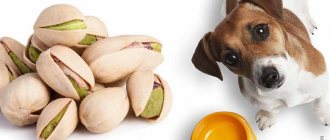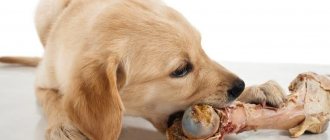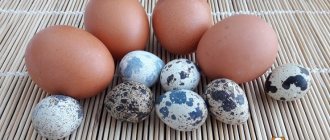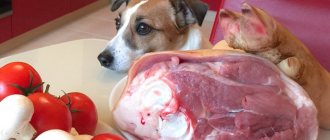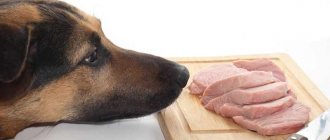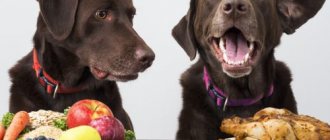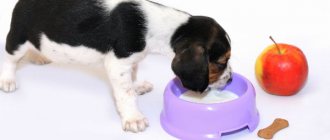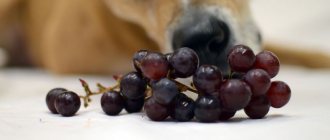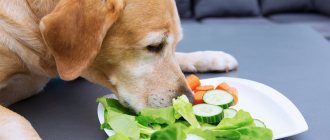Sometimes we care about our pets more than ourselves. Trying to control everything - social circle, place to walk, diet, toys, leisure, love affairs, we forget that dogs are wild pack animals, which, moreover, are predators by nature.
In the wild, they survive in circumstances where humans would not have a chance. This thought should be present in our heads every time we ask the question “can my pet do this?”
All decisions that the owner makes affect the dog’s health in one way or another, so each issue must be considered from different points of view, weighing all the pros and cons.
Benefit
The use of paws for dogs has virtually no contraindications. The composition of the product is such that it contains everything a pet needs:
animal protein - to strengthen the muscles and bones of the animal;- gelatin, found in cartilage, promotes the growth and strengthening of bone tissue;
- fat is necessary for the formation of enzymes and hormones;
- Collagen is the building material of tissues throughout the body; this by-product contains up to 70% of the total protein mass.
Chewing cartilage and soft bones correctly forms and strengthens the dog’s jaw apparatus. Inexpensive and nutritious, by-products are ideal for feeding medium and large breed dogs.
Chicken by-products are used as a reward for training. They are easy to dose and convenient to take with you on a walk.
Veterinarians' opinion
Experts do not have a clear opinion on whether or not to give chicken heads to dogs. Most veterinarians believe that this by-product is useless for animals, and even harmful for puppies.
Arguments against"
calcium in the bones of the skull is in a modified state, so it is not absorbed by the body;- when cooked, the bones become denser and sharper, so they are difficult to digest;
- even when crushed, the head can cause injury to the esophagus and intestines;
- You can’t sharpen your teeth on chicken bones like you can on beef bones;
- cooked offal loses its energy value.
Other experts, on the contrary, believe that you can feed your pet chicken products, following a number of rules.
Is it possible for puppies
Owners of dogs under 1 year old often cannot find reliable information about whether it is possible to give paws to growing pets.
The offal is introduced into the puppy’s diet, but only in boiled form. Before heat treatment, the legs are thoroughly washed, claws are removed and boiled. This minimizes the chances of the animal contracting an infection or damaging the oral mucosa or teeth during eating.
The nutrients contained in chicken by-products provide everything a growing dog's body needs..
What by-products are dogs allowed and what are they not?
By-products occupy a significant place in a dog’s diet. It is allowed to give your pet the following:
- Chicken heads.
- Neck.
- Chicken liver.
- Paws and wings after careful processing.
- Stomachs and hearts.
- Meat.
- Frame (back).
These products can be safely included in the animal’s diet. However, there are by-products that are unacceptable in a dog's diet. These include tubular bones. After processing, this product becomes quite fragile and, under pressure, can break into many small fragments, which, if it enters the pet’s stomach, can damage it. As a result, surgery may even be required to save the animal.
Attention! It is not recommended to give your dog any boiled bones. The raw product is processed quite simply in the dog’s stomach, but the boiled product turns into dust, which then negatively affects the condition of the entire body.
In addition, fried and smoked foods are also unacceptable in the diet; it is also better to avoid grilling.
Liver is useful, but you can only give it a couple of times a week
Raw paws
They are given to adult dogs and adolescents, but only after thermal or mechanical treatment. First, the product is washed under running water and the claws are removed.
To avoid injury to the esophagus, the main tubular bone is removed, and the treat becomes completely safe for the animal.
For adult dogs, it is enough to pour boiling water over their paws; for puppies, boil them until fully cooked (the meat and cartilage should be softened).
Boiled paws
It is better to boil chicken offal for a short time or prepare jellied meat. The gelatin that is released during the process is useful for adult dogs with musculoskeletal problems and growing puppies to strengthen bone tissue.
Heat treatment helps prevent infection from entering the dog’s body. Large bones soften during cooking and will not damage the mucous membrane or digestive tract of the animal.
How and how much to cook
If raw paws are frozen, they are left to thaw or put in the microwave for 2 minutes, setting the defrost mode. Then the product is washed well.
Use kitchen scissors to carefully cut off all the claws. It is important that no small cartilage or bones remain.
Before preparing paws for puppies, the tough skin is removed from the offal. The legs are soaked in cold water for at least 2 hours, after which the skin is removed like a glove.
After preparation, the offal is boiled:
- Pour 2 liters of water into a large saucepan (at least 3 liters).
- Turn on the burner and bring the water to a boil over high heat.
- Place 0.5 kg of cleaned, washed paws into boiling water.
- After boiling, remove the gray cloudy foam and turn down the heat.
- It is recommended to boil the paws for 10 minutes for adult dogs and at least 40 minutes for puppies.
A few minutes before the end of cooking, add a bunch of dill or parsley to the broth. Boiled paws are given to dogs as a separate dish or with porridge and vegetables.
Chicken feet: pros and cons of offal, nutritional value, consumption standards, examples of dishes
The benefits and harms of chicken feet are of interest to buyers. No one argues that chicken itself has valuable properties. But few people know what to do with the legs. Most often they are bought for feeding animals.
In fact, this is a useful and valuable part of the carcass, from which you can prepare delicious dishes: broth, jellied meat, roast, soup. In addition, paws have medicinal properties, which will be presented in the article, along with recipes.
What are the benefits of chicken feet?
When many consumers see chicken legs in a store, they simply don’t understand why they are being sold. The beneficial properties of this part of the chicken are appreciated in China, Japan and other Asian countries. The point is the antihypertensive properties of the product.
The composition of the paws includes minerals:
- calcium and phosphorus;
- sodium and potassium;
- iron and zinc;
- copper and selenium.
A large set of vitamins of groups B, A, E, PP, K. B, choline and other beneficial substances have a strengthening effect on the nervous, immune and skeletal systems.
The chemical composition of chicken legs is as follows. 100 g contains:
- 14.6 g fat;
- 19.4 g protein;
- 0.2 g carbohydrates;
- 66.8 g water;
- there is no ash.
The calorie content of 100 g of the finished product is only 215 Kcal, this attracts people with weight problems.
Are chicken feet healthy?
Since the paws contain many useful substances, there can be no talk of serious harm if this product is not abused (although there are contraindications). A person who regularly consumes a dish made from offal feels healthier, and problems with the motor system disappear.
Chicken feet benefit the entire human body.
What are the benefits of chicken feet for joints?
The benefits of the by-product outweigh the harm:
- The collagen contained in chicken feet is good for bones, tendons, and mucous membranes.
- The skin, thanks to a special protein, becomes healthy and elastic.
- Connective tissue is restored in the joints, fluid production increases, which enhances the mobility of the limbs.
- When bones are injured, cartilage grows faster at the fracture site.
Attention! Chicken feet do not harm, but benefit the joints, especially with arthrosis, arthritis, and osteochondrosis. Chicken legs are especially useful for people over 50 years of age, since the body is not able to synthesize its own protein, which leads to joint diseases and fractures.
Chicken legs are especially useful for people over 50 years of age, since the body is not able to synthesize its own protein, which leads to joint diseases and fractures.
Dried paws
This treat is well suited for medium and small breed dogs. The product is popular among pet owners.
Dried paws are useful due to their natural composition; they contain a rich set of amino acids and microelements. In the process of eating them, the dog cleans the oral cavity, getting rid of plaque and tartar.
Dry paws are useful, but more often they are not used as a food product, but only as a reward. It is not recommended to feed your dog such “dry foods” regularly.
You can purchase this dog treat at a pet store or prepare it yourself.
Briefly about the main thing
- Chicken bones injure the internal organs of dogs, which can cause the death of a pet;
- There are no nutrients in the bones; they will not satisfy your hunger;
- An adult dog should not constantly chew on something;
- A dog can brush its teeth with treats or toys from a pet store;
- Beef and pork bones are included in the permitted list;
- Allowed foods can only be given raw;
- Turkey, rabbit and fish are just as harmful as chicken;
- First aid is the “candle method”: wax “neutralizes” sharp corners;
- If you see blood in your vomit or feces, call your veterinarian.
Drying process
This dish can be prepared in a regular kitchen oven on a wire rack.
First, it is important to make sure that the dog is able to chew a fairly hard treat. It is not recommended to give it to puppies.
Procedure:
Rinse paws under running water and remove claws.- Lightly beat the offal with a kitchen hammer.
- Line a baking sheet with parchment paper.
- Place the raw legs on it in one layer.
- Place the baking sheet in the oven preheated to +150°C.
The product can be completely dried in 1.5–2 hours. The dog is given them occasionally as a treat. This product is not suitable for adequate nutrition of an animal, because it has low nutritional value and causes constipation.
Consequences of eating bones. First aid
The most harmless result of eating bones can be scratches in the mouth, but more often than not, such a dangerous meal can lead to :
- damage or loss of teeth.
- changes in bite;
- development of caries;
- bone getting stuck in the throat - injury, suffocation;
- trauma to the stomach, intestines;
- vomiting, diarrhea, constipation;
- rupture of the digestive organ;
- peritonitis and blood poisoning.
The result of these risks can be painful death.
What to do if the dog stole and ate a bone?
- Monitor your pet's condition. If you have symptoms such as vomiting or diarrhea with blood, immediately take your dog to a veterinary hospital, urgent surgery is needed.
- Do not induce vomiting or give your pet laxatives! A sharp spasm can move the static bone, which can damage the lining of a dog's digestive organs.
- The maximum that owners can give is 2-3 tablespoons of any vegetable oil (sunflower, flaxseed, olive), which, due to its enveloping effect, can help gently remove bones from the intestines.
Veterinarian Olga Leonidovna Korkh advises using the “church candle method” in this situation. The wax melts in the stomach, forms a lump around the sharp object, perfectly enveloping the dangerous parts, thereby giving the pet time before the doctor arrives and, accordingly, a chance to live.
- You need to take a church wax candle, remove the wick;
- Cut into small “tablets”;
- Feed it to the dog (small breed - a couple of centimeters of wax, large breed - half a candle);
- Give wax three times a day along with regular food;
- At the first appearance of blood, call the veterinarian.
Aspic
There is another useful way - jellied meat. Veterinarians and experienced dog breeders consider this option of offal to be optimal and safest for dogs of different breeds and ages.
Large amounts of thick liquid are not recommended.
Preparation:
Wash the paws (0.5 kg) and beat them lightly with a kitchen hammer. The joints are especially well worked out to release synovial fluid.- A small piece of lard (200–300 g) is cut into small pieces.
- Fill the pan with 3 liters of water, add paws and lard.
- Place the container on the stove, bring to a boil, reduce the heat as much as possible (the liquid should not boil, but bubble slightly).
- Cook the jellied meat for 2 hours.
10 minutes before the end of cooking, add a bunch of dill or half a head of onion to the liquid. As soon as the mass has cooled, the bones are taken out of it, leaving only soft tissue.
How to give
The finished jellied meat is placed in a cool place for 8–10 hours.
The product is given to the dog 1-2 times a day as a separate dish or along with porridge. Before serving, remove all small bones and their fragments from the jelly mass. They feed the dog for 2-3 days, then take a break for 2 weeks, then prepare the healthy treat again.
Jellied meat is recommended for growing puppies; it is rich in glucosamine, calcium, and collagen. These substances contribute to the rapid growth of the animal, strengthening the skeleton, bone tissue and joints.
When consumed regularly, the dish replaces industrially produced chondroprotectors.
How to cook chicken legs correctly?
So, how to cook chicken legs so that, for example, your men fall in love with these dishes forever? You must understand that your efforts are not in vain, right?
Yes, precisely, the most delicious first courses - soups - are made from the legs, and therefore, when preparing them, you must observe the subtleties that are appropriate for each of them.
In total, there are more than a hundred chicken soups, ranging from simple ones with noodles to some sophisticated ones.
The main thing is to remember the advantage of chicken meat as dietary meat, low in calories and, at the same time, very pleasant to the taste.
If you plan to cook chicken noodle soup for lunch or dinner today, listen to the advice about choosing it, since it should not just be any kind, but preferably homemade. Then the soup will turn out much tastier than with store-bought noodles and will have more beneficial internal properties.
How to cook chicken legs in a saucepan:
- In order for a boiled ham to be healthy and tasty, it must be fresh. It is not recommended to buy frozen legs, as they may have been defrosted and re-frozen many times. It is better to purchase the meat chilled. As for appearance, the ham should have thin skin with a soft pink or beige color.
- If you were unable to find a chilled leg and bought a frozen one, then you must defrost and rinse it before cooking. Let it dry a little, place it in a saucepan and pour water into it so that the leg is hidden in it. Cook the meat first over medium heat and finally over low heat.
- In order to get not only chicken legs, but also chicken broth, salt the water at the rate of 1 teaspoon per 1 liter. water. If you do not need broth, then salt must be added 15-20 minutes after the start of cooking.
- To give the ham a rich aroma, add various spices to taste to the water after it boils. This could be garlic, pepper, bay leaf, etc.
- The leg will be completely ready in 40-50 minutes. To determine readiness, carefully pierce it with a knife or fork. If it is easily pierced, then you can turn off the burner. Boiled chicken legs are ready.
How to cook chicken legs in a slow cooker:
The ham will be more tender, nutritious and tasty if you cook it in a slow cooker. In this case, the legs should also be thawed in advance (if they were purchased frozen) and filled with milk or water. You need to cook in the “Stew” mode for 35-45 minutes. For a richer taste, you can add vegetables and spices, but you need to put them in the compartment with the legs.
Additional Ingredients
Offal is not a complete meal in its own right . Boiled or dried, they are given as a treat or reward.
You can make soup from the paws with potatoes, carrots, parsley, dill and onions. But it’s better to boil them with any cereal porridge (barley, buckwheat, millet, rice, oatmeal) and give them as a whole.
Offal is also baked in the oven with any vegetables. This is a good replacement for dry food and diversifies your pet's diet.
Harm
Chicken by-products themselves are not dangerous, but incorrect certification, violation of storage times and rules can harm your pet.
Pet products are not as carefully controlled as human products. If they are not thermally treated, there is a possibility that the animal will become infected with an infectious disease.
Large fragments and small cartilages can injure the mucous membranes of the animal’s mouth and digestive tract during eating.
This is especially true for dogs who greedily pounce on food and swallow it without chewing. Feeding should be under the control of the owner.
Uncut claws or their remains injure the stomach, causing internal bleeding.
Expert opinion
Panteleeva Irina Petrovna
Breeder, 11 years experience.
Do not give your domestic dog the tubular chicken bones that are located at the base of the leg. When ground with teeth, they break up into small sharp fragments, which damage the esophagus and stomach of the animal, causing constipation.
Reviews
“The dog is a predator! Do you think someone cuts the beaks and claws for the wolf? They all eat great and feel great! Our Prince (shepherd) eats chicken heads all his life, he is in excellent health, he is very large and strong. I put one and a half kilograms of chicken heads on a pan of porridge (rice or buckwheat). In the morning there are a dozen paws. I don’t cook them, I put them in the microwave at five tons.”
Irina, Vladivostok
“Mila once ate bones... I thought we wouldn’t save her. They performed abdominal surgery. Luckily, she pulled through. I will never give her any bones or offal. Dry food is better. I don’t want to save on her health.”
“I wouldn’t recommend giving bones, heads, necks. But the stomach, liver, and heart are useful, such products should be included in the menu of dogs of any breed (if there are no allergies).”
Restrictions
Paws should not be given to small breed dogs.
Bones may be too hard for them. Large animals are offered the offal without restrictions, but always after heat treatment or mixed with porridge. You should not give paws that have been stored for more than 4 months, even frozen. They are not given to puppies until 6 months of age.
Pregnant and lactating bitches are offered paws only after prolonged heat treatment.
Dogs fed dry food may experience diarrhea or vomiting after switching to natural food. To digest meat, you need several times more enzymes than commercial ready-made food. For this reason, dyspeptic disorders occur.
What can replace chicken?
An alternative is turkey, it is low in calories, rich in vitamins A, E, potassium, sodium, magnesium, iron, has little fat, and is easily digestible. The process of raising this bird is rarely accompanied by the use of hormones and antibiotics; most dog lovers prefer turkey meat when creating a menu for their pet.
Usually, with natural feeding, the basis of the diet is beef, rich in nutrients, but it does not contain all the necessary microelements.
Other alternative meats include:
- mutton;
- horsemeat;
- venison;
- pork;
- rabbit meat.
Lamb is valued for its high potassium and magnesium content and low cholesterol.
Horsemeat is easily digestible, rarely causes an allergic condition, but is of little nutritional value for active dogs.
Venison is valued for its usefulness and uniqueness, has a beneficial effect on cardiac activity and the functioning of the gastrointestinal tract, and is considered a delicacy; not every owner will be able to pamper a pet with such a treat if he is not a hunter.
There is a lot of controversy about pork; many owners prefer to find an alternative to it or only serve it boiled.
Rabbit meat is a healthy product, but is contraindicated for animals with kidney and biliary tract diseases.
It is important for the animal to organize a balanced diet, including dairy products, eggs, fish, cereals, fruits, vegetables, and herbs.
